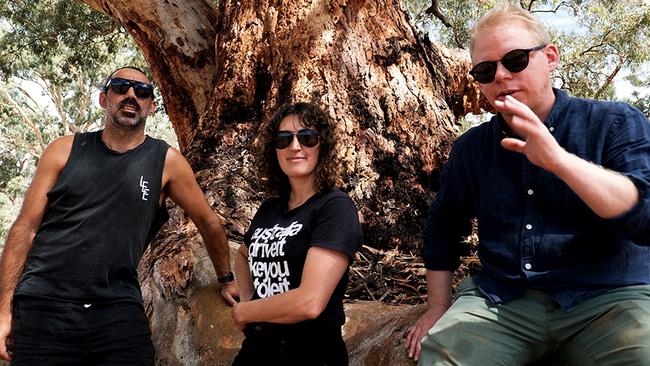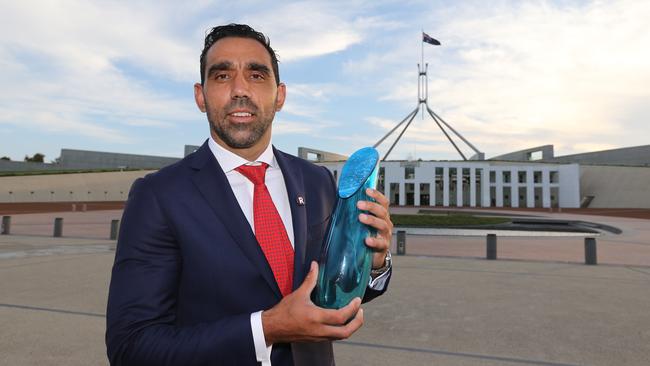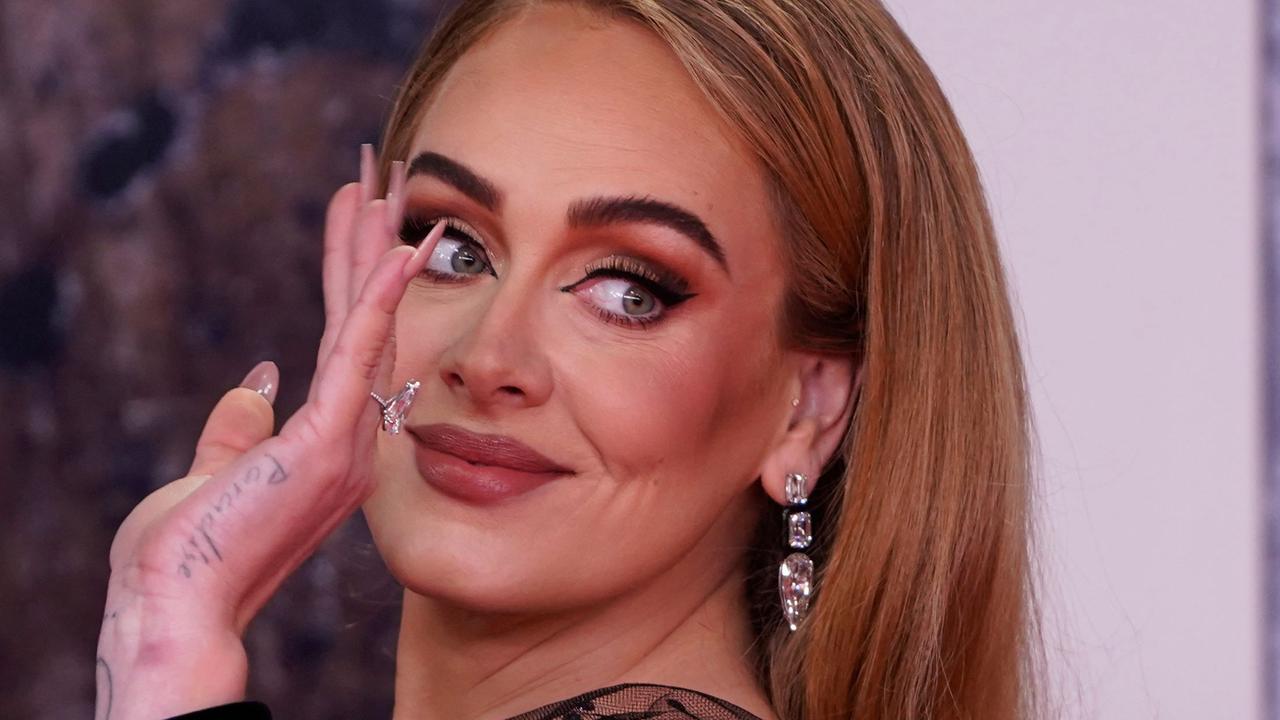Adam Goodes: ‘I don’t think about footy at all’ | SA Weekend
It might surprise some people, Adam Goodes says, “but I don’t think about footy at all’. So what is on his mind these days? Riley Walter caught up the former AFL champion to find out.
SA Weekend
Don't miss out on the headlines from SA Weekend. Followed categories will be added to My News.
It’s been almost seven years since Adam Goodes hung up his footy boots for good.
He’s made the occasional appearance on television screens since then – most notably in 2019 documentaries The Australian Dream and The Final Quarter, which both explored the tumultuous final years of his career – but he has largely remained out of the public eye.
Even so, the Sydney Swans games record holder is unmistakably recognisable walking through the halls of Adelaide’s Museum of Discovery.
His hair is longer, pulled back in a tight bun, his beard more closely cropped and tinged with grey. But his physical presence is still as commanding as when he was at the peak of his footballing powers. It’s hard not to be a little awestruck as he strides past.
He offers a friendly smile and nod as he passes by so as to not interrupt a conversation.
“Adam,” he later introduces himself with a half wave from across the table, two-thirds of the way through his brunch, even though his profile means non-football fans would have likely heard of him at some point.
We are here to listen to Dr Baden Pailthorpe, a contemporary artist and senior lecturer at the Australian National University School of Art and Design, as he introduces the Ngapulara Ngarngarnyi Wirra (Our Family Tree) artwork, which made its official Adelaide debut at the museum later that day having already welcomed about 20,000 visitors since its interstate launch in February.
Goodes slips out of sight into a room up the hallway but his voice is still audible.
Artificially, at least.
The sound of the ex-footballer and proud Adnyamathanha and Narungga man performing a Welcome to Country echoes from a small display at the far end of the hallway he has just passed through carrying the morning’s dirty plates and coffee mugs.
Later he seems relaxed and at ease in his surroundings.
“It might surprise people but I don’t think about footy at all,” Goodes suggests.

Goodes is back in the state where he was born to help showcasea four-year project especially close to his heart.
The Tracker Data Project, a collaboration between Goodes, Pailthorpe and technologist Professor Angie Abdilla, is a remarkable, artificial intelligence-driven project that combines on-field GPS data collected during Goodes’ playing career, with the ancient Adnyamathanha kinship system.
The system and meaning behind it is thoughtful and complex (more of that later) but the end result is a magnificent, towering piece of immersive art in the form of a digitally recreated multi-coloured red gum, with limbs reaching in every direction.
It is formed via an elaborate collection of GPS tracking data from Goodes’ playing career, coupled with the sounds of the wind captured during filming on Adnyamathanha Country, which comprises the northern part of the Flinders Ranges.
It also uses the voices of Goodes and an Uncle, with the centrepiece being the red gum from outback South Australia, which holds a special place in Goodes’ heart, and that of his extended family.
The work was launched in South Australia late last month at the Museum of Discovery, or M.O.D., on North Tce.
At first reading, it may seem like an unusual way to display the on-field movements of one of the game’s greatest players, but doing something outside of the norm was the goal for the Tracker Data Project team.
“What I do see when I walk in that room,” Goodes says, “I see my culture, I see a very significant tree, I see my data exactly how I would envisage it connecting with my culture, where it’s everywhere; it’s all connected, it looks exactly the same because it is the same.
“I am the tree on Country, I am the riverbed, I am the rocks.”
Goodes says the project started out as exploring the “possibilities of my dataset and how we could creatively tell the story”.
“Over the four years it’s really unearthed itself to us what it was going to be. There wasn’t a point where we said, ‘Wouldn’t it be cool if we did this?’,” he says, finishing his morning bite.
“So for me it’s a way of showcasing that; here’s a snapshot of me and my dataset and this is what I was, at that moment in time. Running, jumping; emotionally, physically – how I was at that exact moment in time.”
The beauty of the artwork is the on-field moments have been randomly chosen; we will never know from exactly where they emanate.
They could be from the highest highs of Goodes’ career – his Brownlow years in 2003 and 2006, his premierships in 2005 or 2012, or from the lowest of the lows during his final few years in the game.
“It’s from a random game,” Pailthorpe adds, as the lights on the metres-tall screen dance and twirl like a swarm of fireflies.
“I didn’t choose a particular one. We didn’t want it to be like, ‘What game is this? Oh, it’s that game. Where is that moment?’.
“It’s not about that; in a way, it’s not about the specificity of a game – it’s about what it represents overall.”

The final few years of Goodes’ career and what happened during them have been well documented.
The “booing” saga that lasted for much of the 2014 and 2015 seasons and divided the football world took its toll and would finally force him from the game.
He has maintained a relatively low public profile since, in footy terms at least, and brought smiles to the faces of his many supporters when he joined former teammates for a lap of honour to commemorate the 10-year anniversary of their 2012 premiership.
Today, Goodes is reluctant to talk about that period of his life, his only reference being that he would like to compare data from when he played at his best with the last two years of his career. But, likewise, there is no bitterness when he talks. He just isn’t interested.
“I haven’t thought about it,” the 2014 Australian of the Year says softly when asked if he was left with a bad taste in his mouth after leaving football.
“The last seven years has always been about moving on from that period.
“There’s nothing I could say or do during that period to change people’s opinions or get it to stop so for me it was all about, ‘OK, well what positive things can I be doing in my life?’
“And that’s where I’ve decided to stay.”
A lot can happen in seven years, and Goodes says he’s completely moved on.
“Two kids – that’ll wipe your memory,” Pailthorpe chimes in, drawing a chuckle from Goodes.
For Goodes, footy is the furthest thing from his mind. His work now is about connecting to his roots. It wasn’t until the end of the 2012 AFL season, after that famous grand final win over Hawthorn, that he visited Adnyamathanha Country.

It was on one of his trips back since then that he felt the pull of a centuries-old red gum (wirra), which is the heart of the Ngapulara Ngarngarnyi Wirra artwork.
That particular tree, which Goodes estimates is more than 500 years old, has been a significant meeting place for the Adnyamathanha and was the location of first contact with Europeans for his people, Goodes says.
In the early stages of planning Ngapulara Ngarngarnyi Wirra, even before the project had taken shape, Goodes decided Pailthorpe and Abdilla needed to see the tree for themselves.
“I’ve always been drawn to it, I’ve always felt connected to it so it just made sense that I took these two up there to experience it … once they saw the tree … they really did start to understand why it was so significant,” he says.
The group laughs that Goodes had talked for years about “this tree” but when Pailthorpe and Abdilla finally made the Covid-delayed trip, they knew the landmark would be the centrepiece of the artwork.
To do this, the tree was 3D scanned, creating a point cloud that makes the tree seem like it is being seen with thermal imaging technology.
“There are so many big, beautiful trees up there but that one is something else so when we saw it, it was like, ‘Ah, okay, I get it’,” Pailthorpe remembers.
“And it kind of encapsulates the project in a way: How do you describe all of these things?
“Even the tree is impossible to describe. You can’t do it justice with words – it’s so much bigger than a human vocabulary.”
Abdilla, whose heritage is from the Tasmanian palawa and trawlwoolway people, remembers precisely the moment she felt the connection Goodes had spoken of for so long.
“That moment when we arrived, it was with Adam’s family and there was a smoking (ceremony) before we actually even saw the tree,” she remembers.
“We stopped and Adam’s Aunt called in the ancestors, which is what you hear when you first enter the space … our first interconnection and introduction to the wirra was as you hear it there in the work, so it was quite a moment. I remember walking around and seeing it and going, ‘Oh my god’.”

“Not many things make Adam look small,” Pailthorpe laughs.
“But this one (tree) certainly does.”In essence, it is that profound connection thegroup hastried to replicate in Ngapulara Ngarngarnyi Wirra, without people having to travel about eight hours from Adelaide through the Flinders to visit the tree.
Goodes, Pailthorpe and Abdilla hope the immersive experience will allow visitors to better understand the centuries-old connection between Aboriginal people and Country. The challenge was to do that in both a culturally sensitive and engaging way.
That’s where Abdilla comes in.
“Angie came to us, which was great because we’d probably still be talking about it,” Pailthorpe laughs.
Abdilla explains that AI was used as a tool to more deeply tell the stories of the Adnyamathanha people.
“It’s quite unusual to use any form of AI when you don’t have a problem state,” she says.
“We were looking for a way to create that relationship and interconnection.”
Abdilla trained a neural network – basically a series of algorithms – with the winds and the voices, which each represented the North and South wind: the two winds which form the Adnyamathanha kinship.
The network then output the soundscape and programmed the movement of the tree. Then came the GPS data.
Pailthorpe says the raw data from one game is displayed in about 90,000 rows of an Excel spreadsheet, making envisioning it as an artwork particularly difficult.
“It’s like the worst budget you’ve ever seen,” Pailthorpe says, laughing.
The group also welcomes the fact the data used to track Goodes throughout his playing career can now be used to help explore wider issues around the treatment of First Nations people. “There’s a history of colonial violence and tracking and power,” Pailthorpe says.
“What does it mean for Adam to be tracked in that way and there be no cultural framework around that data?”
It means quite a lot, it turns out, and it’s something the group hopes to explore again, budget permitting.

“The value of that data is just increasing every day,” Goodes says with a wry smile.
Pailthorpe and Abdilla laugh at the inside joke.
This is clearly early steps in a much longer journey for Goodes and his collaborators.
Goodes does not appear desperate to forget about football, just to be more focused on exploring the part of him that fell by the wayside during his playing days.
“The biggest thing for me is that connection has now been made,” he says.
“My job, the project that we’re working on here … it’s all about culture and culture is always at the heart of it.
“I’m just really blessed that I was able to reconnect back into that 10 years ago.”
The Ngapulara Ngarngarnyi Wirra (Our Family Tree) by The Tracker Data Project is being shown at the Museum of Discovery, North Tce, Adelaide, until December.



